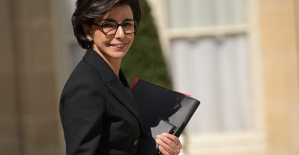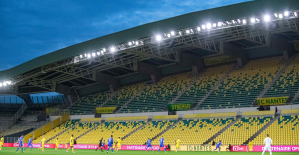Apparently Olaf Scholz has learned little from the Corona crisis. Again and again, high-ranking politicians sat in TV studios or on podiums at press conferences at the peak of the pandemic and promised “no vaccination”, “no new school closures” or “the end of the measures”. And then things turned out differently.
In his "Basta" letter, with which he wants to end the nuclear power plant dispute, the chancellor now writes that all three nuclear power plants in Bavaria, Baden-Württemberg and Lower Saxony that are still operational should be able to continue operating "at the latest by April 15, 2023". The Green Bundestag Vice-President Katrin Göring-Eckardt picked up the ball and made a commitment on Monday evening on ARD: In mid-April there would finally be an end to nuclear power in the German grids.
But the energy crisis will not be over in the spring of 2023. On the contrary: The winter of 2023/24 could pose even greater challenges for society and industry. The Deputy Director of the International Monetary Fund (IMF) said that this winter was "difficult, but the winter of 2023 could be even worse". And even then the traffic light will not want to risk a blackout.
Sure, Scholz had to accommodate the Greens so as not to experience more headwind from their ranks than he is doing now anyway. And the fact that he may have managed to unify the traffic lights on the nuclear power issue for the time being is to the Chancellor's credit. He has shown leadership.
The Greens and the FDP are fighting over the lifetime of the remaining German nuclear power plants. Now a decision comes from the chancellor. "The nice thing about Germany is that in the end it's not the Green Party Congress that decides whether there is enough electricity," comments Jan Fleischhauer.
Source: WORLD / Jan Fleischhauer
The fact that the FDP is (for the time being) more satisfied with the compromise than the Greens is actually absurd. The journalist Malte Kreutzfeldt calculated it on Twitter: The FDP wanted to leave three nuclear power plants on the grid by spring 2024, i.e. a total of 39 additional months of nuclear power.
According to their party congress resolution, the Greens, on the other hand, wanted to leave two nuclear power plants online by April 2023 - as many as Economics Minister Robert Habeck had announced. In the end it would be - following Scholz's current word of power - 3.5 months more: one more nuclear power plant (Emsland) by April 2023. The FDP would have enforced less than ten percent of its demand.
But his clear statement on April 15 could still fall on Scholz. It could have been a pre-determination that was too early – and then in the spring of 2023 the Federal Chancellor will again have to hope for pragmatic, non-ideological coalition partners. In any case, the FDP has already announced that it intends to advocate for terms beyond April 15, 2023. And that's just as well.

 Iran-Israel conflict: what we know about the events of the night after the explosions in Isfahan
Iran-Israel conflict: what we know about the events of the night after the explosions in Isfahan Sydney: Assyrian bishop stabbed, conservative TikToker outspoken on Islam
Sydney: Assyrian bishop stabbed, conservative TikToker outspoken on Islam Torrential rains in Dubai: “The event is so intense that we cannot find analogues in our databases”
Torrential rains in Dubai: “The event is so intense that we cannot find analogues in our databases” Rishi Sunak wants a tobacco-free UK
Rishi Sunak wants a tobacco-free UK Alert on the return of whooping cough, a dangerous respiratory infection for babies
Alert on the return of whooping cough, a dangerous respiratory infection for babies Can relaxation, sophrology and meditation help with insomnia?
Can relaxation, sophrology and meditation help with insomnia? WHO concerned about spread of H5N1 avian flu to new species, including humans
WHO concerned about spread of H5N1 avian flu to new species, including humans New generation mosquito nets prove much more effective against malaria
New generation mosquito nets prove much more effective against malaria The A13 motorway closed in both directions for an “indefinite period” between Paris and Normandy
The A13 motorway closed in both directions for an “indefinite period” between Paris and Normandy The commitment to reduce taxes of 2 billion euros for households “will be kept”, assures Gabriel Attal
The commitment to reduce taxes of 2 billion euros for households “will be kept”, assures Gabriel Attal Unemployment insurance: Gabriel Attal leans more towards a tightening of affiliation conditions
Unemployment insurance: Gabriel Attal leans more towards a tightening of affiliation conditions “Shrinkflation”: soon posters on shelves to alert consumers
“Shrinkflation”: soon posters on shelves to alert consumers The restored first part of Abel Gance's Napoléon presented at Cannes Classics
The restored first part of Abel Gance's Napoléon presented at Cannes Classics Sting and Deep Purple once again on the bill at the next Montreux Jazz Festival
Sting and Deep Purple once again on the bill at the next Montreux Jazz Festival Rachida Dati: one hundred days of Culture on the credo of anti-elitism
Rachida Dati: one hundred days of Culture on the credo of anti-elitism The unbearable wait for Marlène Schiappa’s next masterpiece
The unbearable wait for Marlène Schiappa’s next masterpiece Skoda Kodiaq 2024: a 'beast' plug-in hybrid SUV
Skoda Kodiaq 2024: a 'beast' plug-in hybrid SUV Tesla launches a new Model Y with 600 km of autonomy at a "more accessible price"
Tesla launches a new Model Y with 600 km of autonomy at a "more accessible price" The 10 best-selling cars in March 2024 in Spain: sales fall due to Easter
The 10 best-selling cars in March 2024 in Spain: sales fall due to Easter A private jet company buys more than 100 flying cars
A private jet company buys more than 100 flying cars This is how housing prices have changed in Spain in the last decade
This is how housing prices have changed in Spain in the last decade The home mortgage firm drops 10% in January and interest soars to 3.46%
The home mortgage firm drops 10% in January and interest soars to 3.46% The jewel of the Rocío de Nagüeles urbanization: a dream villa in Marbella
The jewel of the Rocío de Nagüeles urbanization: a dream villa in Marbella Rental prices grow by 7.3% in February: where does it go up and where does it go down?
Rental prices grow by 7.3% in February: where does it go up and where does it go down? With the promise of a “real burst of authority”, Gabriel Attal provokes the ire of the opposition
With the promise of a “real burst of authority”, Gabriel Attal provokes the ire of the opposition Europeans: the schedule of debates to follow between now and June 9
Europeans: the schedule of debates to follow between now and June 9 Europeans: “In France, there is a left and there is a right,” assures Bellamy
Europeans: “In France, there is a left and there is a right,” assures Bellamy During the night of the economy, the right points out the budgetary flaws of the macronie
During the night of the economy, the right points out the budgetary flaws of the macronie These French cities that will boycott the World Cup in Qatar
These French cities that will boycott the World Cup in Qatar Champions League: France out of the race for 5th qualifying place
Champions League: France out of the race for 5th qualifying place Ligue 1: at what time and on which channel to watch Nantes-Rennes?
Ligue 1: at what time and on which channel to watch Nantes-Rennes? Marseille-Benfica: 2.99 million viewers watching OM’s victory on M6
Marseille-Benfica: 2.99 million viewers watching OM’s victory on M6 Cycling: Cofidis continues its professional adventure until 2028
Cycling: Cofidis continues its professional adventure until 2028


















